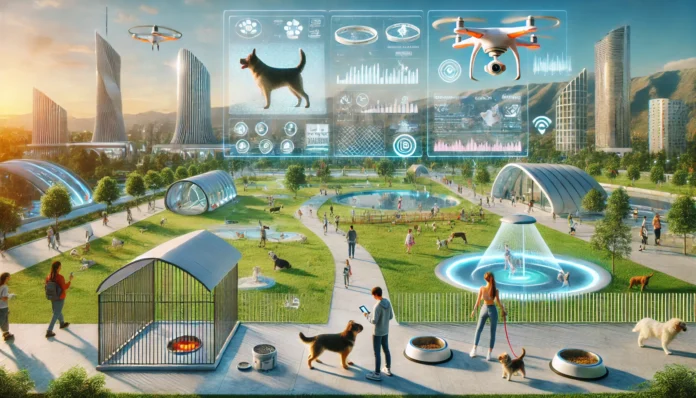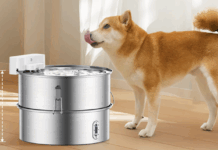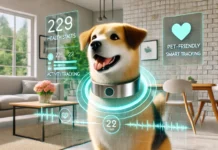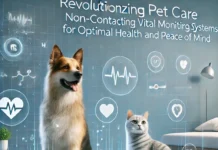Last Updated on February 3, 2025 by Dogs Vets
In recent years, technology has permeated every aspect of our lives, revolutionizing how we work, communicate, and even care for our pets. As dog owners, we are witnessing a significant transformation in pet care, driven by innovative technologies that promise to enhance the well-being of our furry companions. From smart collars that monitor health metrics to AI-powered apps that offer personalized training, the future of pet care is here, and it is tech-driven.
This article explores the various ways technology is transforming dog ownership, providing insights into the latest trends, benefits, and challenges. We will also discuss how these advancements can improve the quality of life for dogs and their owners, and what the future holds for pet care technology.
The Rise of Pet Tech: An Overview
The pet care industry has seen a surge in technological innovations, collectively known as “pet tech.” These technologies range from wearable devices and smart feeders to telemedicine platforms and AI-driven apps. The global pet tech market is projected to reach $20 billion by 2025, reflecting the growing demand for tech solutions in pet care.
1. Wearable Technology for Dogs
Wearable technology is not just for humans; dogs are now benefiting from smart devices designed to monitor their health and activity levels. These devices, often in the form of collars or tags, can track a dog’s location, activity, and vital signs.
Smart Collars
Smart collars are equipped with GPS, accelerometers, and sensors that monitor a dog’s activity and health. They can track steps, calories burned, heart rate, and even detect signs of distress or illness. Some advanced models can also provide real-time location tracking, ensuring that your dog is always safe and secure.
Benefits:
- Health Monitoring: Continuous monitoring of vital signs can help detect early signs of health issues.
- Safety: GPS tracking provides peace of mind, especially for owners of dogs that tend to wander.
- Behavior Analysis: Data on activity levels can help owners understand their dog’s behavior and make informed decisions about their care.
Examples:
- FitBark: A smart collar that tracks activity, sleep, and overall health.
- Whistle: Combines GPS tracking with health monitoring to provide a comprehensive view of your dog’s well-being.
2. Smart Feeding Solutions
Feeding your dog has never been easier, thanks to smart feeding solutions that allow for precise control over your pet’s diet. These devices can be programmed to dispense specific portions of food at scheduled times, ensuring your dog receives the right amount of nutrition.
Automated Feeders
Automated feeders can be controlled via smartphone apps, allowing owners to feed their dogs remotely. Some models also include cameras and microphones, enabling video calls with your pet.
Benefits:
- Portion Control: Helps prevent overfeeding and obesity.
- Convenience: Allows for flexible feeding schedules, especially for busy pet owners.
- Monitoring: Some feeders include cameras and sensors to monitor eating habits and detect changes in appetite.
Examples:
- Petnet SmartFeeder: Offers portion control and remote feeding via a smartphone app.
- Catspad: A smart feeder that also monitors water intake and provides fresh water.
3. Telemedicine and Remote Veterinary Care
The COVID-19 pandemic accelerated the adoption of telemedicine across various industries, including pet care. Telemedicine platforms allow pet owners to consult with veterinarians remotely, providing access to professional advice without the need for an in-person visit.
Virtual Consultations
Virtual consultations can be conducted via video calls, phone calls, or chat services. They are particularly useful for routine check-ups, behavioral consultations, and follow-up visits.
Benefits:
- Convenience: Eliminates the need for travel and waiting rooms.
- Accessibility: Provides access to veterinary care for pet owners in remote areas.
- Cost-Effective: Often more affordable than in-person visits.
Examples:
- Vetster: Offers on-demand virtual consultations with licensed veterinarians.
- Airvet: Provides a comprehensive telemedicine platform for pet owners and veterinarians.
4. AI-Powered Pet Care Apps
Artificial intelligence is playing a significant role in the future of pet care, with AI-powered apps offering personalized recommendations and insights. These apps can analyze data from wearable devices, feeding solutions, and other sources to provide actionable advice.
Personalized Recommendations
AI algorithms can analyze data on a dog’s activity, diet, and health to offer personalized recommendations for care. This can include diet plans, exercise routines, and health tips tailored to your dog’s specific needs.
Benefits:
- Customization: Provides tailored advice based on individual dog profiles.
- Proactive Care: Helps identify potential health issues before they become serious.
- Data-Driven Insights: Offers insights based on comprehensive data analysis.
Examples:
- Petcube: Uses AI to analyze pet behavior and provide personalized care recommendations.
- Felcana: An AI-driven app that offers insights into your dog’s health and behavior.
5. Robotics and Automation
Robotics is another area where technology is making waves in pet care. From robotic toys to automated cleaning solutions, robots are helping pet owners provide better care for their dogs.
Robotic Toys
Robotic toys can keep dogs entertained and engaged, providing mental and physical stimulation. Some models can be controlled remotely via smartphone apps, allowing owners to interact with their pets from a distance.
Benefits:
- Entertainment: Provides hours of entertainment and exercise.
- Engagement: Encourages interaction and play, strengthening the bond between owner and pet.
- Convenience: Offers a hands-free way to keep dogs entertained.
Examples:
- Zoomer: A robotic dog that responds to voice commands and offers interactive play.
- Mousr: A robotic mouse toy that engages cats and small dogs in play.
The Benefits of Technology in Pet Care
The integration of technology into pet care offers numerous benefits for both dogs and their owners. Here are some of the key advantages:
1. Improved Health Monitoring
Wearable devices and smart collars provide continuous health monitoring, allowing for early detection of potential health issues. This can lead to better health outcomes and a higher quality of life for dogs.
2. Enhanced Safety
GPS tracking and remote monitoring ensure that dogs are safe and secure, even when they are not in the immediate vicinity of their owners. This is particularly important for dogs that are prone to wandering or have a tendency to escape.
3. Personalized Care
AI-powered apps and personalized recommendations enable owners to provide tailored care for their dogs, based on individual needs and preferences. This can lead to more effective and efficient pet care.
4. Convenience and Accessibility
Technology makes pet care more convenient and accessible, with features like remote feeding, virtual consultations, and automated cleaning. This is especially beneficial for busy pet owners and those living in remote areas.
5. Data-Driven Insights
The data collected by pet tech devices and apps can provide valuable insights into a dog’s behavior, health, and well-being. This information can help owners make informed decisions about their pet’s care and lifestyle.
Challenges and Considerations
While technology offers many benefits, there are also challenges and considerations to keep in mind. Here are some of the key issues:
1. Data Privacy and Security
The collection and storage of pet data raise concerns about privacy and security. Owners must ensure that their data is protected and that they are aware of how it is used.
2. Cost
The cost of pet tech devices and services can be a barrier for some owners. It is important to weigh the benefits against the costs and consider whether the investment is worthwhile.
3. Reliability and Accuracy
The reliability and accuracy of pet tech devices can vary, and it is important to choose reputable brands and products. Owners should also be aware of the limitations of these technologies and use them as a complement to, rather than a replacement for, traditional pet care.
4. Over-Reliance on Technology
While technology can enhance pet care, it is important not to become overly reliant on it. Owners should continue to engage with their pets, provide emotional support, and maintain a strong bond.
The Future of Pet Care Technology
As technology continues to evolve, the future of pet care looks promising. Here are some trends and developments to watch for:
1. Advanced Health Monitoring
Future devices will offer even more advanced health monitoring, with features like blood glucose monitoring, ECG tracking, and more. This will enable owners to monitor their dog’s health in real-time and detect potential issues early.
2. Integration with Smart Homes
Pet tech will become more integrated with smart home systems, allowing for seamless control and monitoring. For example, smart collars could trigger home automation systems to adjust lighting, temperature, and security based on the dog’s location and activity.
3. AI-Driven Personalization
AI will play an even larger role in pet care, with algorithms offering more personalized and accurate recommendations. This will enable owners to provide the best possible care for their dogs, based on individual needs and preferences.
4. Virtual and Augmented Reality
Virtual and augmented reality could be used to create immersive experiences for dogs, providing entertainment and mental stimulation. For example, virtual walks or interactive games could be used to keep dogs engaged and entertained.
5. Robotics and Automation
Robotics will continue to advance, with more sophisticated robots and automated solutions entering the pet care market. This could include robotic companions, automated grooming solutions, and more.
Frequently Asked Questions
1. What is pet tech?
Pet tech refers to the integration of technology into pet care, including wearable devices, smart feeders, telemedicine platforms, and AI-driven apps. These technologies are designed to enhance the well-being of pets and provide convenience for pet owners.
2. How can technology improve my dog’s health?
Technology can improve your dog’s health by providing continuous health monitoring, early detection of potential issues, and personalized care recommendations. Wearable devices and smart collars can track activity, monitor vital signs, and detect signs of distress or illness.
3. Are pet tech devices reliable?
The reliability of pet tech devices can vary, and it is important to choose reputable brands and products. Owners should also be aware of the limitations of these technologies and use them as a complement to, rather than a replacement for, traditional pet care.
4. What are the benefits of telemedicine for pet owners?
Telemedicine offers numerous benefits for pet owners, including convenience, accessibility, and cost-effectiveness. It allows for remote consultations with veterinarians, providing access to professional advice without the need for an in-person visit.
5. How can AI enhance pet care?
AI can enhance pet care by analyzing data on a dog’s activity, diet, and health to offer personalized recommendations for care. This can include diet plans, exercise routines, and health tips tailored to your dog’s specific needs.
Conclusion
The future of pet care is being transformed by technology, offering new opportunities and challenges for dog owners. From wearable devices and smart feeders to telemedicine and AI-driven apps, technology is providing innovative solutions that enhance the well-being of pets and provide convenience for owners.
As we look to the future, it is important to embrace these advancements while also being mindful of the challenges and considerations. By doing so, we can ensure that our furry companions receive the best possible care and enjoy a high quality of life.

















